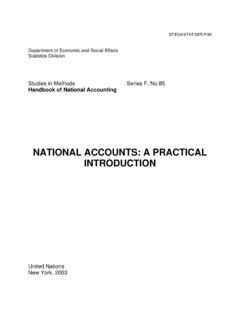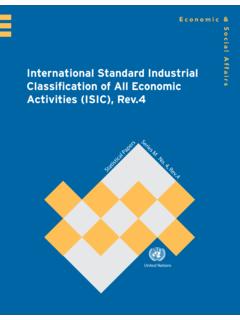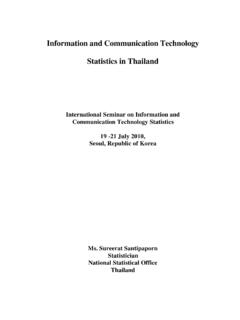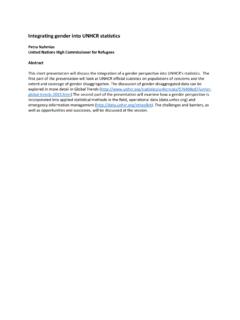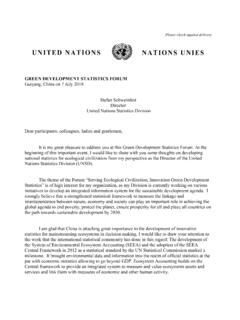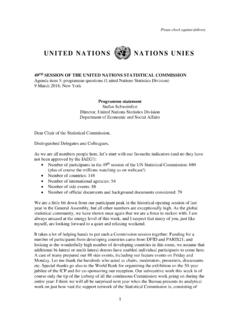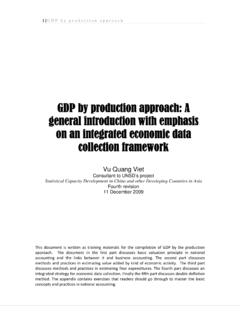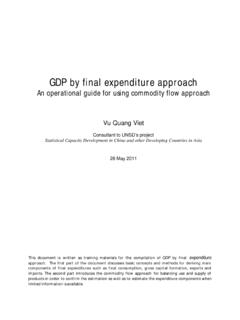Transcription of System of National Accounts - United Nations
1 System of System of National Accounts 2008. National Accounts 2008. European Commission International Monetary Fund European Commission International Monetary Fund Organisation for USD 150 Economic ISBN 978-92-1-161522-7 Co-operation and Development United Nations Printed at the United Nations , New York World Bank Organisation for Economic United Nations World Bank 08-44065 December 2009 6,750 Co-operation and Development System of National Accounts 2008. European Commission International Monetary Fund Organisation for Economic United Nations World Bank Co-operation and Development New York, 2009. European Commission International Monetary Fund Print stock code SNA EA 2008 001. Organisation for Economic Co-operation and Development OECD Code 302009191P1.
2 United Nations Sales No. , document symbol ST/ESA/ World Bank ISBN 978-92-1-161522-7. Copyright 2009. European Communities, International Monetary Fund, Organisation for Economic Co-operation and Development, United Nations and World Bank All rights reserved Foreword The System of National Accounts , 2008 (2008 SNA) is a statistical framework that provides a comprehensive, consistent and flexible set of macroeconomic Accounts for policy making, analy- sis and research purposes. It has been produced and is released under the auspices of the United Nations , the European Commission, the Organisation for Economic Co-operation and Devel- opment, the International Monetary Fund and the World Bank Group. It represents an update, mandated by the United Nations Statistical Commission in 2003, of the System of National Accounts , 1993, which was produced under the joint responsibility of the same five organiza- tions.
3 Like earlier editions, the 2008 SNA reflects the evolving needs of its users, new develop- ments in the economic environment and advances in methodological research. A working group, comprising representatives of each of our organizations, managed and coor dinated the work. National statistical offices and central banks from countries through- out the world made valuable contributions. Expert groups carried out research on the issues being reviewed. An advisory expert group was established to provide expert opinions from a broad range of countries. During the update work, the recommendations and the updated text were posted on the website of the United Nations Statistics Division for worldwide comment, thereby achieving full transparency in the process.
4 The 2008 SNA is intended for use by all countries, having been designed to accommodate the needs of countries at different stages of economic development. It also provides an overarching framework for standards in other domains of economic statistics, facilitating the integration of these statistical systems to achieve consistency with National Accounts . At its fortieth session, the Statistical Commission unanimously adopted the 2008 SNA as the international statistical standard for National Accounts . We encourage all countries to compile and report their National Accounts on the basis of the 2008 SNA as soon as possible. BAN Ki-moon Jos Manuel Barroso Angel Gurr a Secretary-General President Secretary-General United Nations European Commission Organisation for Economic Co-operation and Development Dominique Strauss-Kahn Robert B.
5 Zoellick Managing Director President International Monetary Fund The World Bank Group Summary table of contents iii Table of contents .. vii List of xli List of figures .. xlv Preface .. xlvii List of abbreviations and acronyms .. lv Chapter 1: Introduction ..1. Chapter 2: Overview ..15. Chapter 3: Stocks, flows and accounting rules ..39. Chapter 4: Institutional units and sectors ..61. Chapter 5: Enterprises, establishments and industries ..87. Chapter 6: The production account ..95. Annex to chapter 6: Separating output due to storage from holding gains and 127. Chapter 7: The distribution of income Accounts ..131. Chapter 8: The redistribution of income Accounts ..157. Chapter 9: The use of income Accounts ..179.
6 Chapter 10: The capital account ..195. Chapter 11: The financial account ..219. Chapter 12: The other changes in assets Accounts ..237. Chapter 13: The balance sheet ..257. Chapter 14: The supply and use tables and goods and services account ..271. Chapter 15: Price and volume measures ..295. Chapter 16: Summarizing and integrating the Accounts ..325. Chapter 17: Cross-cutting and other special issues ..341. Chapter 18: Elaborating and presenting the Accounts ..395. Chapter 19: Population and labour inputs ..405. Chapter 20: Capital services and the National Accounts ..415. Chapter 21: Measuring corporate activity ..427. Chapter 22: The general government and public sectors ..435. Chapter 23: Non-profit institutions.
7 455. Chapter 24: The households sector ..461. Chapter 25: Informal aspects of the economy ..471. Chapter 26: The rest of the world Accounts and links to the balance of payments ..483. Chapter 27: Links to monetary statistics and the flow of funds ..499. Chapter 28: Input-output and other matrix-based analyses ..507. Chapter 29: Satellite Accounts and other extensions ..523. Annex 1:The classification hierarchies of the SNA and associated codes .. 545. Annex 2: The sequence of Accounts ..561. Annex 3: Changes from the 1993 System of National Accounts ..581. Annex 4: Research Agenda ..603. References .. 611. 617. Index .. 635. v vi Table of contents List of tables ..xli List of figures ..xlv Preface ..xlvii List of abbreviations and acronyms.
8 Lv Chapter 1: Introduction ..1. A. What is the System of National Accounts ? ..1. B. The conceptual elements of the SNA ..2. 1. Activities and transactions .. 2. 2. The institutional sectors of the economy ..2. 3. Accounts and their corresponding economic The goods and services account .. 3. The sequence of Accounts .. 3. Current Accounts .. 3. Accumulation Accounts .. 3. Balance sheets .. 4. Other Accounts of the SNA .. 4. Supply and use 4. Accounts in volume 4. C. Uses of the SNA ..4. 1. Monitoring the behaviour of the 4. 2. Macroeconomic 3. International comparisons ..5. D. The boundaries of the 1. Non-monetary transactions .. 6. 2. The production boundary ..6. Household 6. Other production boundary 7. 3. The consumption 4.
9 The asset 5. National boundaries ..7. 6. Final consumption, intermediate consumption and gross fixed capital formation ..8. Human 8. Repairs, maintenance and gross fixed capital formation .. 8. E. The SNA as a coordinating framework for statistics ..9. 1. Harmonization between different statistical 9. 2. The use of microdata for macroeconomic accounting ..9. F. Links with business 1. International accounting 11. G. Expanding the scope of the SNA ..11. H. The SNA and measures of welfare ..12. 1. Qualifications to treating expenditure as a welfare measure .. 12. 2. Unpaid services and welfare ..12. 3. The impact of external events on welfare ..12. 4. The impact of externalities on vii System of National Accounts 5. Non-economic impacts on 6.
10 Welfare indicators and macroeconomic Chapter 2: Overview ..15. A. Introduction ..15. 1. Analysing flows and 2. Recording flows and B. The conceptual elements of the 1. Institutional units and 17. Institutional sectors .. 17. Delimitation of the total economy and the rest of the world .. 17. 2. Transactions and other Main types of transactions and other flows .. 18. Characteristics of transactions in the SNA .. 19. 3. Assets and 4. Products and producing units ..19. 19. Producing units .. 19. 5. Purposes ..20. C. Rules of 1. Introduction .. 20. Terminology for the two sides of the 20. Change of ownership and the recording of transactions in goods and 20. Double entry or quadruple entry accounting .. 21. 2. Time of 3.
